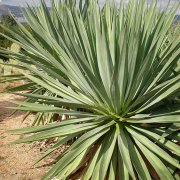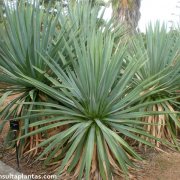Care of the succulent plant Furcraea bedinghausii or False agave |
|
The genus Furcraea, family Agavaceae, includes about 20 species of succulent plants, mostly native to Mexico and the Caribbean. Some species are: Furcraea bedinghausii, Furcraea selloa, Furcraea tuberosa, Furcraea andina, Furcraea cabuya. Common names: Colombian fique, False agave. This species is native to southern México. They are succulent plants that form attractive rosettes of leaves that reach 2 meters (6.56 feet) in height. The long leaves with slightly toothed margins are bluish-green; they are erect at first and bend downward over time. The flowers are greenish white and appear in a long pyramidal inflorescence that reaches 5 meters (16.4 feet) in height. They bloom once every 10-20 years and the mother plant dies but first produces bulbils to propagate itself. False agave is used in rockeries, on dry and sunny slopes, to form barriers and as isolated specimens. It's ideal for Mediterranean climate gardens. Furcraea bedinghausii grows in full sun and partial shade exposures. It resists frost down to -5 ºC (23 ºF) if the substrate is dry. The soil can be normal, well-drained garden soil with plenty of coarse sand or gravel. Colombian fique is a very resistant to drought plant that need occasional watering in spring and summer; reduce watering in fall and no watering in winter. Furcraea bedinghausii does not need fertilizer. False agave is a plant resistant to the usual pests and diseases but very sensitive to excess moisture in the roots. Colombian fique is propagated from adventitious bulbils that emerge between flowers and from seeds sown in spring. |
Images of the succulent plant Furcraea bedinghausii or False agave |
Find plants
Furcraea bedinghausii or False agave | Care and Growing
© 2026 FavThemes

